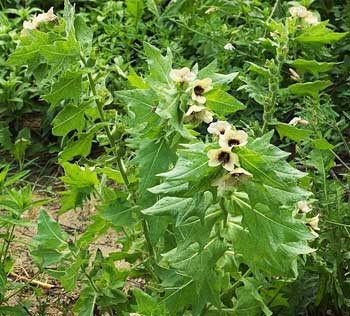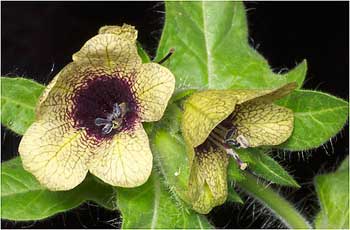Contents:
Common Names | Parts Usually Used | Plant(s) & Culture | Where Found | Medicinal Properties | Biochemical Information
Legends, Myths and Stories | Uses | Warning | Bibliography
Scientific Names

- Hyoscyamus niger L.
- Solanaceae
- Nightshade family
Common Names
- Black henbane
- Devil’s eye
- Fetid nightshade
- Henbell
- Hog bean
- Jupiter’s bean
- Poison tobacco
- Stinking nightshade
Parts Usually Used
Seeds, leaves
Back to Top

Description of Plant(s) and Culture
Henbane is a biennial plant; the brown, spindle-shaped rootstock produces, in the second year, a dirty-green stem covered with sticky hairs and bearing alternate, sticky oblong-lanceolate, sessile leaves. The funnel-shaped flowers are dull yellow or beige, with purple veins and bases, and grow in one-sided, leafy spikes from July to September. The plant has a fetid odor.
Back to Top
Where Found
Found growing in dry, sandy soils, waste grounds and gravelyards and around the foundations of neglected houses in northern states of the United States, and in Canada and Europe.
Back to Top
Medicinal Properties
Anodyne, antispasmodic, calmative, narcotic, analgesic, diuretic, hypnotic
Back to Top
Biochemical Information
Alkaloids including hyoscyamin and atropine, tannin, choline, traces of essential oil. Contains the narcotics hyoscyamine and scopolamine, which are used as pain killers and to induce sleep. Deadly poison without medical supervision.
Back to Top
Legends, Myths and Stories
Once upon a time, henbane was believed to have aphrodisiac properties and was a main ingredient in love potions. Hamlet’s father was murdered by pouring a distillation of henbane in his ear (perhaps he had complained of earache).
Henbane has figured prominently in literature and folklore throughout the ages as a poisonous narcotic similar to belladonna and datura. Therefore, no formulas are attached.
Back to Top
Uses
Because of the danger of poisoning, henbane is used primarily for external applications. An oil obtained from the leaves is made into anodyne lotions and used for earache and rheumatism. A decoction or tincture is sometimes taken for nervousness and irritability or to relieve pain.
It stops perspiration, induces sleep, good for hysteria, irritable cough, asthma, gastric ulcer, colitis, and irritable bladder syndrome.
Externally, apply to old ulcers, sores, gout.
Back to Top
Warning
The whole plant is poisonous. Children have been poisoned by eating the seeds or seed pods. Considered very dangerous when taken internally. Use only under medical supervision.
Back to Top
Bibliography
![]() The Herb Book
The Herb Book, by John Lust, Bantam Books, 666 Fifth Avenue, New York, NY. copyright 1974.
![]() Chinese Medicinal Herbs
Chinese Medicinal Herbs, compiled by Shih-Chen Li, Georgetown Press, San Francisco, California, 1973.
![]() Culpeper’s Complete Herbal & English Physician: Updated With 117 Modern Herbs
Culpeper’s Complete Herbal & English Physician: Updated With 117 Modern Herbs, by Nicholas Culpeper, Meyerbooks, publisher, PO Box 427, Glenwood, Illinois 60425, 1990, (reprint of 1814)
![]() Planetary Herbology
Planetary Herbology, by Michael Tierra, C.A., N.D., O.M.D., Lotus Press, PO Box 325, Twin Lakes. WI 53181., Copyright 1988, published 1992
![]() Indian Herbalogy of North America
Indian Herbalogy of North America, by Alma R. Hutchens, Shambala Publications, Inc., Horticultural Hall, 300 Massachusetts Avenue, Boston, Massachusetts 02115, 1973
![]() Webster’s New World Dictionary
Webster’s New World Dictionary, Third College Edition, Victoria Neufeldt, Editor in Chief, New World Dictionaries: A Division of Simon & Schuster, Inc., 15 Columbus Circle, New York, NY 10023
 An Instant Guide to Medicinal Plants
An Instant Guide to Medicinal Plants, by Pamela Forey and Ruth Lindsay, Crescent Books (January 27, 1992).
